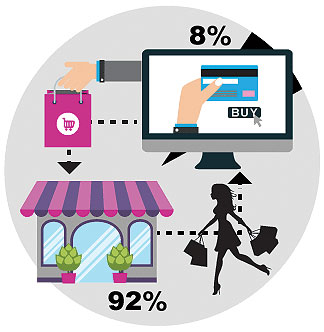The last several years have been all about beauty marketers and retailers embracing digital. For good reason too, as e-commerce has been the fastest growing retail channel in the U.S. beauty market, advancing at a compound annual growth rate of 24% since 2009. In a turn of events, Kline observes the opposite occurring in 2014, as digital pure plays are increasingly expanding beyond the virtual world into the physical one.
Birchbox, the pioneer of online subscription sampling, opened its first physical store in New York City in 2014, followed by its first holiday pop-up shop for men later in the year. The firm has also teamed up with Gap to bring Birchbox to seven U.S. locations through pop-up shops.
Similarly, Violet Grey, which offers edited beauty collections online, opened a store in Los Angeles, while Credo Beauty, an online natural beauty retailer, also opened its first physical location in San Francisco, hoping it will be the start of a chain.
“The flurry of online retailers entering the physical world signifies yet another paradigm shift in beauty retailing,” notes Karen Doskow, Director of Kline’s Consumer Products practice. “While everyone else has been flocking online, online pure plays are becoming physical. Omni-channel retailing strengthens both ways as retailers and marketers strive to offer channel agnostic consumers the convenience of shopping in physical stores and online.”
Technology is also playing a key role in transformation of the beauty retailing environment. Many physical retailers are working to blend online and offline together through technological enhancements, such as diagnostics tools like Sephora Color IQ, augmented reality mirrors, such as the iMirror, and online tutorials. Beacon technology that informs shoppers of information and special offers when in stores is implemented by all types of physical retailers during 2014.
Moreover, brands that were once only sold via infomercials, such as Guthy-Renker’s Meaningful Beauty and WEN, can now also be found in Sephora and Ulta. Some of Atlantic Coast Media Group’s infomercial brands including Miracle Skin Transformer and Hydroxatone are available in Kohl’s revamped beauty departments.
Amazon, the behemoth of all virtual pure plays, has also begun to go physical. In February 2015, the company introduced its first staffed on-campus pick-up and drop-off service at Purdue University and had previously experimented with pop-up shops. Amazon has also leased space in New York City which could possibly become its first retail store, as reported by the Wall Street Journal in October 2014.
Outside of beauty, Google opened a series of pop-up shops for the 2013 holiday season while other online retailers have opened physical storefronts, including clothier Bonobos and eyeglasses purveyor Warby Parker.
Despite its rapid ascension, virtual channels account for only 8% of total U.S. beauty and personal care sales while physical stores account for the vast majority, according to the Beauty Retailing USA report. “This movement underscores the continued relevance of bricks and mortar in an increasingly digital world,” adds Doskow.
Beauty Retailing USA: Channel Analysis and Opportunities is a comprehensive analysis of the complex environment for retailing cosmetics and toiletries in the United States. With detailed channel and retailer profiles, this insightful study provides a clear view of the challenging and ever-changing retail landscape specific to beauty and personal care products.

